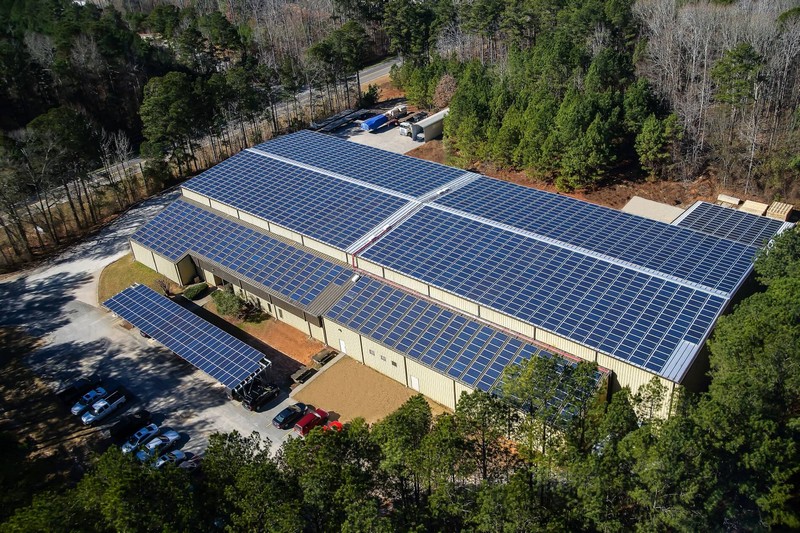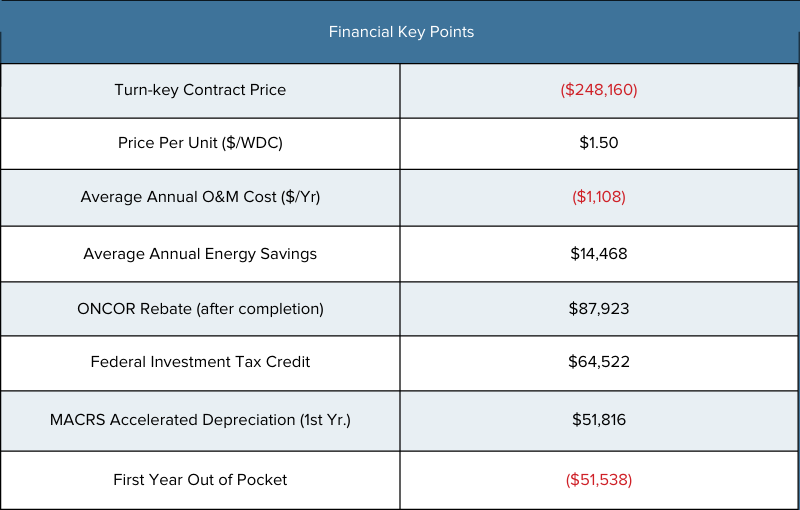It wasn’t long ago that tree hugger was a slang term for folks concerned with the environment. In hindsight, these people likely deserved more praise than ridicule. Fast forward just a few short decades, and global warming is discussed with increasing frequency and a problem that solar energy can help combat.
 Consequently, solar energy has seen widespread growth in recent years. In some cases, the environmental feel-good of adding solar is responsible for its popularity.
Consequently, solar energy has seen widespread growth in recent years. In some cases, the environmental feel-good of adding solar is responsible for its popularity.
However, for others, installing a new roof and solar while obtaining a return on investment (ROI) in just a few years is highly intriguing. For both groups, the idea of experiencing reduced energy costs and a positive cash flow for the life of the building is often a deciding factor.
Regardless of the reasoning, solar energy makes “cents” for many building owners today. As a result, learning more about solar energy can be a great way to increase your business!
How Solar Can Increase Your Business
Educating your customers about the possibilities of using solar energy on their facilities helps them save money and gives you a way to separate yourself from competitors.
Imagine meeting with a customer and sharing that they could get a new metal roof AND solar and have it paid for within 5-10 years with much of the cost covered by other people. Energy savings and incentives make the short ROI (return on investment) possible.
Additionally, many companies now set Environmental, Social, and Governance (ESG) goals. Solar energy is a great path to achieving ESG goals.
McElroy Metal’s Solar Journey
Much like your commercial customers, we own buildings to operate our business. Consequently, we’d like to share our experiences using solar on our facilities to help you gain some owner insight into this topic.
While we don't sell solar products, to say we’ve been pleased with our solar experiences would be an understatement. At McElroy Metal, we’re proud that we have installed solar applications on four of our manufacturing facilities and are currently working on the fifth and sixth with no intentions of stopping there.
In fact, according to our Vice President of Marketing, Ken Gieseke, “we plan to install solar on any of our facilities where the financial investment makes sense.”
Our first solar project dates back to 2014 at our manufacturing facility in Peachtree City, GA, where we installed a 500 kW system and have been selling energy back to the local utility for eight years.
We’re making more money from producing electricity than we’ve spent purchasing electricity, so we’ve effectively created an additional revenue stream. Click here to read more about the project.
 McElroy Metal facility in Peachtree City, GA
McElroy Metal facility in Peachtree City, GA
Solar Partners
.jpg?width=400&name=Ken%20and%20Peter%20on%20Roof%20Low%20Res%20(1).jpg) It is fair to say from products to providers to incentives; we’ve seen quite a bit of change in the solar industry during our involvement over the last twenty years.
It is fair to say from products to providers to incentives; we’ve seen quite a bit of change in the solar industry during our involvement over the last twenty years.
Ken shares, “finding a good solar partner is the most important thing you can do. They literally handle all of the backend work. They help you do everything from finding available incentives to running ROI calculations. We couldn’t accomplish what we have without great partners like Inovateus Solar located in South Bend, IN and Spear C&I LLC in New Braunfels, TX.”
Incentives
Based on our experience, we learned that identifying incentives at the city, state, and federal levels is critical. In some cases, local power companies offer additional incentives.
While that may seem overwhelming to navigate, the various solar companies do almost all the heavy lifting to locate incentives. Beyond that, you might also find information from www.dsireusa.org helpful since they offer a database of incentives by state.
 Identifying incentives makes all the difference for system feasibility. We looked at putting a solar system on our Marshall, MI manufacturing facility a few years ago.
Identifying incentives makes all the difference for system feasibility. We looked at putting a solar system on our Marshall, MI manufacturing facility a few years ago.
Unfortunately, the numbers didn’t make sense from a cost and ROI perspective, so we tabled the idea. Thanks to new incentives our partner recently identified, we’re now moving forward at our Marshall facility and installing solar panels soon.
Case Study:
Our recent solar installation at our facility in Sunnyvale, TX recently is a great example of the impact incentives make. The initial decision to evaluate solar at the facility was prompted by a solar incentive program by the local utility company (Oncor). The charts below demonstrate the impact of local and federal incentives.
When reviewing the data below, it’s important to remember that while these charts include only the solar system cost, solar partners can easily include the cost of the metal roof into the equation (often referred to as a proforma.)
Showing owners how they can pay for a new roof and solar in a 5-10 year window, with much of the cost covered by incentives from local and state governments, can be highly effective.
-Distributed-Generation-(DG)-System-(800%20%C3%97%20450%20px).png?width=734&name=Solar-Photovoltaic-(PV)-Distributed-Generation-(DG)-System-(800%20%C3%97%20450%20px).png)

.png?width=734&name=cash-purchase-rooftop-solar-system%20(1).png)
%20(2).png?width=800&name=solar-metal-roofing-payback-period%20(800%20%C3%97%20510%20px)%20(2).png)
Given the projected output of the solar system, we expect a payback period of roughly 5.4 years. The incentives and initial investment occur in year one, while the earned energy savings act as the long-term positive cash flow for the project's life.
Products to Host Solar Systems
Once you’ve decided that offering solar may be a great way to grow your business, it’s time to consider the core roofing product you’ll install below the solar system. While you can install solar systems over almost any roofing material, you should consider two main points:
Longevity. Most solar panels have a 25-year power warranty to hedge against rising energy costs. Since the lifespan of solar systems often exceeds 25+ years, the longevity of the primary roofing material should meet or exceed the life expectancy of the solar system.
When longevity isn’t considered, owners face the frustrating decision to remove a perfectly good solar system simply to replace a worn-out roof.
Shingle and membrane-type materials often require replacement earlier than solar systems, given their short life expectancy. Of course, after new roof installation, owners can reinstall the solar system, but that carries additional labor and costs which can take years to recoup.
In contrast, installing a new metal roof with a 60+ year life expectancy removes the longevity concern completely. In fact, the original metal roof can likely be used as the host for a second solar system if the first one requires replacement at some point in the future.
Attachment. The attachment of a solar system to the primary roofing system is another consideration. Attaching solar to many roofing products may require drilling holes in and through the roofing material into the substructure below.
In contrast, solar systems attach to standing seam metal roofs via clamps like the S5 product that do not penetrate the metal panel. The ability to attach solar panels without penetrating the roof panel is a significant advantage because any penetration or hole in a roof is an opportunity for a future leak.
Bottom line: Metal roofing is an excellent (if not the best!) host for solar applications.
How to Get Started
Like any new niche market, the first step is to spend some time educating yourself. With the ease of gaining information these days, the world is truly at your fingertips.
Visit websites of solar suppliers, ask to talk to some of their existing contractors, watch social media posts, attend webinars and listen to podcasts like this recent one with Ken Gieseke, McElroy Metal Vice President of Marketing.
Once you understand how the systems work, from financing to installation, then work to identify a supplier or two that you feel aligns well with your business style.
With your knowledge and team in place, you’re ready to find opportunities. While certainly not exhaustive, the following can be good starting points:
- Add solar as an option to a metal roof project you’re currently bidding since this practice can help offset the cost of the new metal roof.
- Place advertisements in your preferred geographical area.
- Add educational solar content and an approach to obtain a quote to your website.
- Identify commercial or industrial projects in your area that need a retrofit or recover.
- Ask to be included on the website of your solar partner.
So does offering solar technology make “cents” for you and your customers? Only you can decide that, but given our experience as a building owner and the abundance of current solar incentives due to global warming concerns, the timing might be perfect.
Contact us if you’d like to chat more about solar and how you can use it to grow your business. We’re here to help!
About McElroy Metal
Since 1963, McElroy Metal has served the construction industry with quality products and excellent customer service. The employee-owned components manufacturer is headquartered in Bossier City, La., and has 14 manufacturing facilities across the United States. Quality, service and performance have been the cornerstone of McElroy Metal’s business philosophy and have contributed to the success of the company through the years. As a preferred service provider, these values will continue to be at the forefront of McElroy Metal’s model along with a strong focus on the customer.



.png?width=767&name=What%20to%20Expect%20When%20You%20Order%20From%20McElroy%20Metal%20(1).png)


.png?width=440&height=293&name=How%20to%20Install%20Metal%20Roofing%20Over%20Existing%20Metal%20Roofs%20(1).png)


Comments on this article:
Scroll down to the bottom to submit a comment and join the conversation. Need help or have a question? Please contact us. Looking for a distributor or contractor? Please click here to get started.